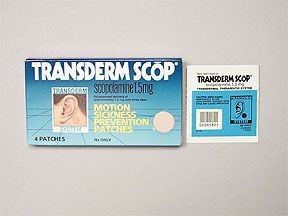
Contents
- 1 Side Effects of Transderm Scop (scopolamine)
- 1.0.1 What are the important side effects of Transderm Scop (scopolamine)?
- 1.0.2 Transderm Scop (scopolamine) side effects list for healthcare professionals
- 1.0.3 What drugs interact with Transderm Scop (scopolamine)?
- 1.0.4 Does Transderm Scop (scopolamine) cause addiction or withdrawal symptoms?
- 1.0.5 Summary
Side Effects of Transderm Scop (scopolamine)
Transderm Scop (scopolamine) is a drug patch used to prevent motion sickness.
- Transderm Scop is administered topically through the skin via a delivery system that releases scopolamine over three days. Scopolamine is absorbed into the body through the skin.
- The mechanism by which scopolamine prevents nausea and vomiting due to motion sickness is unclear. Motion activates the vestibule in the ear, which sends a signal to the vomiting center in the brain, resulting in vomiting for individuals susceptible to motion sickness.
- Scientists theorize that scopolamine blocks communication between the vestibular nerves and the vomiting center in the brain by inhibiting acetylcholine (anticholinergic effect). It may also directly affect the vomiting center.
- Scopolamine must be taken prior to motion sickness for it to be effective.
Common side effects of Transderm Scop include:
- drowsiness
- dry mouth
- blurred vision
- dry/itchy eyes
- pupillary dilation
Serious side effects of Transderm Scop include:
- worsening of narrow-angle glaucoma
- difficulty urinating
- disorientation and confusion
Prolonged use of Transderm Scop may result in withdrawal symptoms like nausea, vomiting, headache, and dizziness.
Wearing patches during an MRI scan may lead to skin burns.
Drug interactions with Transderm Scop include alcohol, tranquilizers, sedatives, and other drugs that cause drowsiness, which may intensify the sedative effects of Transderm Scop.
Transderm Scop slows down the passage of materials, including drugs, through the stomach and intestines, potentially reducing the absorption of certain drugs.
Drugs with anticholinergic effects can enhance the anticholinergic side effects of Transderm Scop. These include belladonna alkaloids, antihistamines, tricyclic antidepressants, and muscle relaxants.
The use of Transderm Scop in pregnant women has not been sufficiently studied, and it passes into breast milk. Consult a doctor before breastfeeding.
What are the important side effects of Transderm Scop (scopolamine)?
The most common side effects are:
- drowsiness
- dry mouth
- blurred vision
- pupillary dilation
Scopolamine may worsen narrow-angle glaucoma, cause difficulty urinating, and result in dry, itchy eyes.
Some patients may experience disorientation and confusion. Prolonged use of Transderm Scop may lead to withdrawal symptoms like nausea, vomiting, headache, and dizziness.
Wearing patches during an MRI scan may cause skin burns. Inform healthcare professionals about the use of medication patches prior to an MRI scan, and remove the patch if necessary.
Transderm Scop (scopolamine) side effects list for healthcare professionals
The following serious adverse reactions are described elsewhere in labeling:
- Acute Angle Closure Glaucoma
- Neuropsychiatric Adverse Reactions
- Eclamptic Seizures in Pregnant Women
- Gastrointestinal and Urinary Disorders
- Drug Withdrawal/Post-Removal Symptoms
- Blurred Vision
- MRI Skin Burns
Clinical Trials Experience
Since clinical trials are conducted under various conditions, the observed adverse reaction rates cannot be directly compared between different drugs or reflect real-life rates.
Motion Sickness
The most common adverse reaction reported was dry mouth. Less common adverse reactions included drowsiness, blurred vision, and pupillary dilation.
PONV
In PONV clinical trials, common adverse reactions occurring in at least 3% of patients are shown in Table 1.
Table 1 Common Adverse Reactions* in Surgical Patients for the Prevention of PONV
| Transderm Scop % (N = 461) |
Placebo % (N = 457) |
|
| Dry mouth | 29 | 16 |
| Dizziness | 12 | 7 |
| Somnolence | 8 | 4 |
| Agitation | 6 | 4 |
| Visual Impairment | 5 | 3 |
| Confusion | 4 | 3 |
| Mydriasis | 4 | 0 |
| Pharyngitis | 3 | 2 |
| *occurring in at least 3% of patients and at a rate higher than placebo | ||
Postmarketing Experience
The following adverse reactions have been reported after the approval of scopolamine transdermal system. Due to the nature of these reports being voluntary and from an uncertain population size, it is difficult to determine their frequency or establish a causal relationship to drug exposure.
Psychiatric disorders: acute psychosis (including hallucinations, disorientation, and paranoia)
Nervous system disorders: headache, amnesia, coordination abnormalities, speech disorder, attention disturbance, restlessness
General disorders and administration site conditions: application site burning
Skin and subcutaneous tissue disorders: generalized rash, skin irritation, erythema
Renal and urinary disorders: dysuria
What drugs interact with Transderm Scop (scopolamine)?
Drugs Causing Central Nervous System (CNS) Adverse Reactions
Concurrent use of Transderm Scop with drugs causing CNS adverse reactions like drowsiness, dizziness, or disorientation (e.g., sedatives, hypnotics, opiates, anxiolytics, alcohol) or drugs with anticholinergic properties (e.g., other belladonna alkaloids, sedating antihistamines, meclizine, tricyclic antidepressants, muscle relaxants) may intensify the effects of Transderm Scop.
Depending on the importance of the drug to the patient, either Transderm Scop or the interacting drug should be chosen. Monitor patients for CNS adverse reactions if simultaneous use is unavoidable.
Anticholinergic Drugs
The concomitant use of scopolamine with other drugs having anticholinergic properties may increase the risk of CNS adverse reactions, intestinal obstruction, and urinary retention. Patients receiving anticholinergic drugs should be monitored more frequently during Transderm Scop treatment.
Oral Drugs Absorbed In The Stomach
As an anticholinergic, Transderm Scop can delay gastric and upper gastrointestinal motility, affecting the absorption rate of orally administered drugs. Monitor patients receiving concomitant orally administered drugs with a narrow therapeutic index for modified therapeutic effects.
Interaction With Gastric Secretion Test
Scopolamine interferes with gastric secretion tests. Discontinue Transderm Scop 10 days prior to the test.
Does Transderm Scop (scopolamine) cause addiction or withdrawal symptoms?
Drug Abuse And Dependence
Controlled Substance
Scopolamine, the active ingredient in Transderm Scop, is not a controlled substance.
Dependence
Termination of Transderm Scop, usually after several days of use, may result in withdrawal symptoms including disturbances of equilibrium, dizziness, nausea, vomiting, abdominal cramps, sweating, headache, mental confusion, muscle weakness, bradycardia, and hypotension.
These withdrawal symptoms indicate that scopolamine, like other anticholinergic drugs, may produce physical dependence. The onset of these symptoms, typically occurring 24 hours or more after removing the patch, can be severe and may require medical intervention.
Summary
Transderm Scop (scopolamine) is an anticholinergic drug patch used to prevent motion sickness. It is administered topically via a specialized delivery system. Common side effects include drowsiness, dry mouth, blurred vision, dry/itchy eyes, and pupillary dilation. The safety of Transderm Scop in pregnant women has not been well-established. Consult a doctor before breastfeeding.


